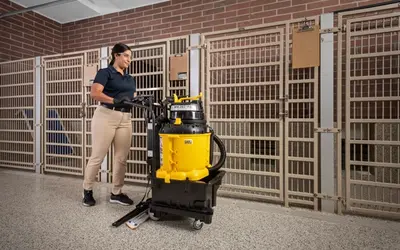How to Clean an Office to Stay Healthy and Productive at Work

Knowing how to clean an office can be the difference between success and failure. It sounds like hyperbole but consider this: employees spend one third of their life at work. If that environment is cluttered, dusty or just plain dirty, workers will not perform at their best. The World Health Organization agrees, noting the number of studies that corollate health, well-being, and well-organized work to a healthy work environment where safety and health are considered.
It’s a no brainer that clients and customers judge a company by the appearance of their offices. That’s why designers specify showier, more expensive, higher-end materials in lobbies, elevators, meeting rooms and other public spaces. Cleaning crews are charged with taking special care of these areas to make them shine. But in a tight labor market, where attracting and retaining quality employees gets harder and harder, treating the entire work environment like a premium public space builds good will and keeps workers happy and healthy.
Read on to learn how to clean an office so all the occupants feel valued and stay safe.
Cleaning an Office: A Landscape of Materials
Cleaning an office sounds pretty straightforward, but it’s not. There’s a variety of spaces with different uses, finishes, furnishings and fixtures to consider. Each has its own cleaning protocols and methods and they may or may not be interchangeable.
When mapping out how to clean an office effectively and efficiently think about the landscape, it’s uses and the materials. There’s the:
- Lobby: This is the main showroom for your company. Floors can be hard surface, think wood, tile, terrazzo, laminate and vinyl or soft surface like carpet and carpet tiles. Or they can be a mix of materials. Information desks offer a place to make a splashy design statement, as can be seen on this Pintrest page. Depending on the message you want to send they can be wood, stone, plastic, brick or an artful pile of peeled logs. Lobbies also have soft guest seating upholstered with fabric or leather and banks of windows that need attention.
- Elevators: Again, materials here can be high end. Look for wood and/or metal detailing that both shows fingerprints and can be tricky to clean.
- Stairwells: Elevators are not the only way to go upstairs. Often thought of as back of house, taking the stairs is an attractive alternative as people try to move more at work. Cleaning these spaces can be difficult and potential slip-and-fall hazards means they can also be dangerous.
- Meeting rooms: Another high-impact space, meeting rooms are designed for comfort and productivity. That means outfitting them with technology like digital whiteboards, ultra-thin TV screens, cameras and more. Dust build up can hurt these expensive machines as can using the wrong cleaning chemicals.
- Break rooms: More back-of-house than client focused, the break room is a workhorse for your staff. It’s also one of the dirtiest places in your office, harboring an alarming number of germs and soils on the sink faucet handles, the microwave handles and buttons, the refrigerator door handle and vending machine buttons.
- Restrooms: No surprises here. A dirty restroom is a universal turn off. Clients and employees alike expect this space to be clean, fresh and healthy. Unfortunately cleaning the tile-and-grout floors and walls with old fashioned technology like mops and rags leave these spaces dirty and bad smelling.
- Work spaces: This is where employees spend the bulk of their time and their cubicles show it. Keyboards and computer mice are dirty, according to a study by Kimberly-Clark Professional but so is the desk itself, along with accompanying pens and pencils.
Touchpoints, the Common Denominator
While the spaces, uses and materials vary, touchpoints are the common denominator in an office building. Identifying and cleaning them well can help keep your staff safe from colds and flu. Ignore them and the downtime will cost you. The flu cost U.S. employers over $21 billion in lost productivity in the 2017 flu season, according to an estimate from Challenger, Gray & Christmas Inc. and reported in Newsday.
Touchpoints tend to be the germiest places in the work place. We know about computer keyboards and restroom door handles but don’t forget other hot spots like the start button on the photocopier, the coffee pot handle, elevator buttons, the kitchen sink, vending machine buttons and perhaps most upsetting, office mugs and the sponge used to clean them.
University of Arizona microbiologist Charles Gerba found that, ‘up to 20 per cent of (clean) office mugs had traces of coliform bacteria (a.k.a. fecal matter) – and once the cups were wiped with a communal dishcloth or sponge, the number jumped up to 100 per cent. After being wiped, 20 per cent of mugs also tested positive for E. coli,’ according to Workopolis.
How to Clean It All?
Kaivac offers a suite of technologies designed to clean all of these spaces and touchpoints efficiently and thoroughly. Protect your office, staff and professional reputation with state-of-the-art tools designed for ease of use and a quick Return on Investment.
Learn more here.
Related Posts

The Best Dog Kennel Cleaning Equipment
There are ways to simplify the kennel cleaning process. Automatic kennel cleaning equipment can simplify the kennel cleaning process and can save hours of daily, back breaking labor–even for facilities without central drains.
Read more
A Better Retail Floor Care Option: How One National Retailer Reclaimed Floor Care
Discover how a national retailer cut costs and improved results by switching to Kaivac’s All Floor™ system—an easy, all-in-one floor care solution perfect for low-revenue retail locations.
Read more